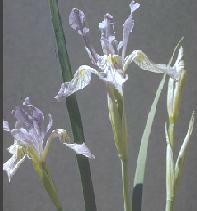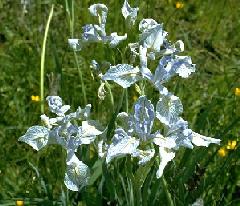

Copyright © 1995 Brother Eric Vogel, St. Mary's College
Rocky Mountain Iris
Iris missouriensis Nutt.
The Rocky Mountain Iris is a perennial herb which grows about 8-20 inches tall., Usually bears from 1 to 4 variegated violet-blue or nearly white flowers about 2-3 inches long. Flowers from mid May through July in mountains. It is found in open wet meadows from lowest valleys to about 9,000 feet. Reported by Wyeth to be found towards the source of the Missouri. Found on the Fort Hall Indian Reservation in Southeastern Idaho.
Caution: Rootstocks, roots, and young shoots may be toxic. Should never be taken internally, but sharp, bitter taste normally inhibits eating. There can be a severe allergic reaction to handling the plant.
Medicinal Uses
Rocky Mountain iris was employed medicinally by several native North
American Indian tribes who used it to treat various complaints, but especially
as an external application for skin problems. It was for a time an officinal
American medicinal plant, but is little, if at all, used in modern herbalism.
The root is emetic and odontalgic. An infusion has been used in the treatment of
kidney and bladder complaints, stomach aches etc. The pulped root is placed in
the tooth cavity or on the gum in order to bring relief from toothache. A
decoction of the root has been used as ear drops to treat earaches. A poultice
of the mashed roots has been applied to rheumatic joints and also used as a
salve on venereal sores Caution is advised in the use of this plant, see the
notes above on toxicity. A paste of the ripe seeds has been used as a dressing
on burns. (PFAF)
Planting
Requires a moist soil, growing well in a moist border, but intolerant of
stagnant water. Easily grown in a sunny position so long as the soil is wet in
the spring. Division, best done after flowering. Another report says that it is
best done in spring or early autumn. Very easy, larger clumps can be replanted
direct into their permanent positions, though it is best to pot up smaller
clumps and grow them on in a cold frame until they are rooting well. Plant them
out in the spring.
